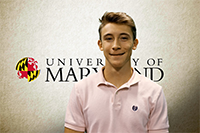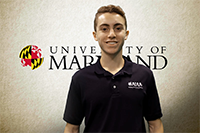AIAA Member Spotlight – October 2017 Written 13 October 2017
Institute Welcomes 2017–2018 Norris Space View Interns JT Lewis and Adam Boro
By Lawrence Garrett, AIAA Web Editor


This month we turn the spotlight on the AIAA Alexander “Al” Norris Space View Internship program’s 2017–2018 interns: John (JT) Lewis, of Prince Frederick, MD, and Adam Boro, of East Brunswick, NJ, both of whom are aerospace engineering majors in the University of Maryland’s Department of Aerospace Engineering in the James A. Clark School of Engineering. JT is scheduled to graduate in 2019, with Adam following in 2020.
Upon learning that he’d been selected as one of two Norris Space View Interns for 2017–2018, JT said he was “extremely excited” about working for “an organization at the forefront of the industry.” He called the opportunity to get to see what AIAA does behind the scenes an exciting one, and said that when he was called by the Institute for an interview, he was “ecstatic, and even more so” when he later received the offer.
Similarly, Adam described feeling “shock, disbelief, and excitement” that he’d been selected as a Norris Space View Intern, adding that he immediately began thinking about all the projects he wanted to work on and “the possibilities” for professional growth serving as an AIAA intern.
Having begun their internships in September, JT and Adam are currently working approximately 7–10 hours a week at AIAA Headquarters and are expected to continue with this schedule through May 2018. Due to the demands of the program’s schedule, candidates for this year’s internship were once again limited to students from accredited engineering programs in the Washington, DC, metro area.
During their time at AIAA Headquarters, JT and Adam are being charged with an assortment of key tasks, one of which is conducting research and gathering important facts and figures about the aerospace and defense sector throughout United States. Using that information, the Institute plans to develop outreach documents that should prove beneficial to participants in the Institute’s 2018 Congressional Visits Day program, August is for Aerospace program, and other public policy activities.
Describing what inspired him to pursue an aerospace engineering career, Adam said that he wanted to be involved in something that will have a “lasting impact, not only on the globe but on the [entire] universe,” noting that he always strives to have a positive impact on those around him. JT said he’s been passionate about aerospace since he was a young boy, sparked by an early obsession with Star Wars, calling the film the biggest reason for his interest in flight. JT also said he’s always had a strong interest in science and math and that aerospace engineering provides an “excellent way to apply those skills.”
This past summer, JT received a unique opportunity to add to his skills, working as an intern in power and propulsion at NAVAIR, helping analyze jet engine performance for the U.S. Navy. This experience, according to JT, made propulsion and power his primary interest moving forward. He noted that one of his favorite college classes to date has been Engineering Thermodynamics. Through these experiences he now has a basic understanding of jet engines and he’s eager to learn more about them
Adam is most passionate about space, he said, “because of all the mysteries that are yet to be discovered,” but he’s also interested in aviation and flight. As Adam put it, “all facets” of aerospace engineering are “captivating” to him. One aspect of aerospace engineering that really fascinates him is that even as more knowledge is constantly being gained, more questions continue to arise, and consequently, “the less we understand,” calling it “a catch-22 in some ways.” Nonetheless, Adam is enthusiastic about a career in such a challenging environment because he thinks “there will never be a point in time where we truly know everything, allowing for discoveries to be made forever.”
In high school, JT prepared himself for studying aeronautical sciences by taking a lot of math and physics courses, including AP Calculus II, an AP Statistics class, and two years of AP Physics. Aside from earning some credits that he can apply toward his college degree, JT said these classes helped him tremendously in establishing a strong background in both math and physics, which he noted is “extremely important for engineering.”
Adam said that many of his preparations focused on teamwork, sharing his observation that from his first moment in college he learned that nearly all classes or projects “require effective communication and leadership skills.” He added that “engineering work is deeply rooted in collaboration and the ability to take leadership,” which he considers one of his strengths.
JT has been privileged to work on a number of fun and informative aerospace engineering projects to date while attending the University of Maryland, including a Rotor Design Project, an Over Sand Vehicle Project, and a Beam Design Project, to name a few. He said he really enjoyed the Rotor Design Project because he was responsible for all of the testing and design of the rotors and because it closely related to his major. While calling the Over Sand Vehicle Project “a ton of work,” JT said that in the end he really learned a lot and that the amount of time put into the project “was worth it.” He added that “the experience of working on a team for that kind of project” was invaluable.
Adam also has had the opportunity to work on a number of team projects at the University of Maryland. Currently, he serves as Media Team Leader on a project called Gamera, a manned-solar-powered helicopter “that has already set a world record for solar-powered flight,” he said. He's also part of the project's Controls Team and Landing Gear Team, where he is working to innovate the aircraft's landing gear by implementing new Piezo sensors, in addition to making structural improvements. As the project's Media Team Leader, Adam created the Gamera website, gamera.umd.edu, and has produced technical animations for the project’s promotional video.
Similar to JT’s experience, Adam said that through his work on the Gamera project, he has come to appreciate “the value of collaboration.” He explained, “We have very skilled, but narrowly focused brains and very different majors. Together, however, we are able to combine our life experiences, build off of each other's strengths, and create a quadcopter that defies the status quo of aviation. I believe that this out of the box thinking and teamwork has led to our success and is a key trait for continuing innovation.”
Both JT and Adam offered sound advice for other students, in high school or college, who want to pursue aerospace as a discipline. JT reiterated the importance of “get[ting] your math in early,” noting that problem solving is a requisite skill. He also advised that it’s an excellent idea to build skills in computer programming, noting that he’s discovered that “aerospace is a very coding-heavy field.” He called it an “extremely valuable skill,” one which he utilized and improved upon every day during his summer internship at NAVAIR.
Adam’s advice was straightforward: “don’t shy away” from an experience you may be afraid of pursuing. “Seek challenges and build yourself to become a better leader,” he said, and “be willing to put in the hard work.”
JT also pointed to the value of his AIAA student membership in pursuit of his aerospace career. He said it gives him “many advantages academically and professionally,” citing the Institute’s online resources, technical documents, events for student branches, and a “head start toward networking with companies in the industry.” Adam also praised the value of his AIAA membership and what it offers in the way of career networking opportunities, social events, and technical publications, in addition to the availability of scholarships.
When asked what design concepts could come to fruition over the next ten years, JT cited three technologies: practical applications for hypersonic flight, reusable rockets, and autonomous flight. He predicted that autonomous flight will “become the single most important method of flight and space travel,” and that eventually all flight “will be done autonomously,” while acknowledging it may take longer than ten years to achieve.
Adam also predicted autonomous flight within ten years—in the form of “flying cars.” In regards to space developments, he forecasted “human habitats on extraterrestrial objects,” and “solar surfing vehicles.”
Looking to their future careers, JT maintained that he already has a good idea of what he’ll be doing ten years from now. He knows he wants to remain in the Washington, DC, metro area, not only because he feels at home here, but also because of the abundant opportunities in aerospace that the region provides, adding that he believes he’ll likely end up back at NAVAIR upon graduation.
With Adam’s strong passion for space, he has made it his goal to pursue becoming an astronaut. While people have told him countless times that this goal is unrealistic, those doubts have only motivated him “to work harder and be more tenacious.” He added that viewing Earth from space has always been his dream, and that he “will do everything within [his] reach to make this a reality.” He also would like to work on a team planning the habitation of Mars or an extraterrestrial object, calling it “a vital step for humanity.”
The Institute congratulates JT and Adam on their selection as the 2017–2018 Norris Space View Interns, as well as their selection as the AIAA Spotlight Members for October 2017. We wish them well as they pursue their academic and professional goals, and look forward to watching them develop into future leaders of our industry.
